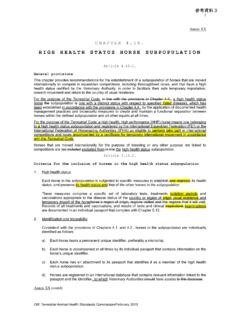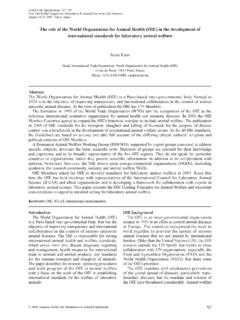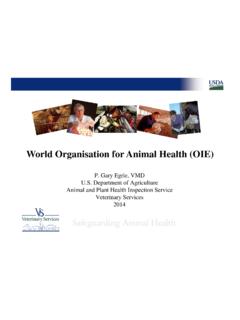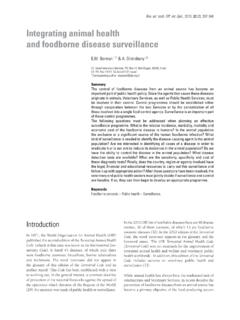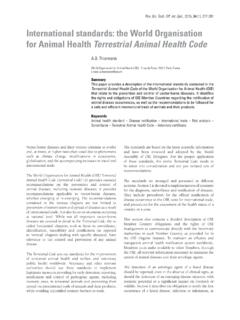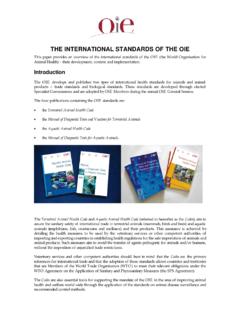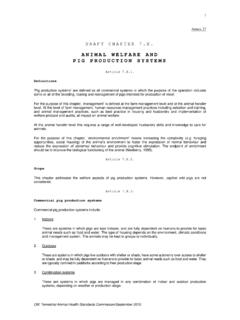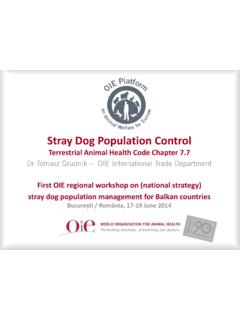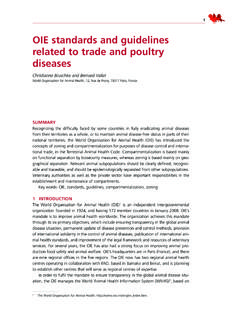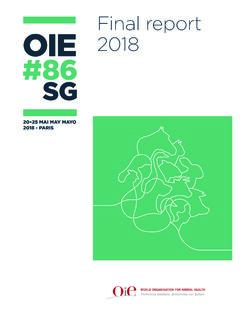Transcription of LEPTOSPIROSIS - World Organisation for Animal Health
1 NB: Ve rsion a dopted by the Worl d A ssembly of De legates of the OIE in May 2014. NB: This disease is no longer listed by the OIE. CHAPTER LEPTOSPIROSIS . SUMMARY. Definition of the disease: LEPTOSPIROSIS is a transmissible disease of animals and humans caused by infection with any of the pathogenic members of the genus Leptospira. Description of disease: Acute LEPTOSPIROSIS should be suspected in the following cases: sudden onset of agalactia (in adult milking cattle and sheep); icterus and haemoglobinuria, especially in young animals; meningitis; and acute renal failure or jaundice in dogs.
2 Chronic LEPTOSPIROSIS should be considered in the following cases: abortion, stillbirth, birth of weak offspring (may be premature);. infertility; chronic renal failure or chronic active hepatitis in dogs; and cases of periodic ophthalmia in horses. Laboratory diagnosis of LEPTOSPIROSIS can be complex and involves tests that fall into two groups. One group of tests is designed to detect anti-leptospiral antibodies, and the other group is designed to detect leptospires, leptospiral antigens, or leptospiral nucleic acid in Animal tissues or body fluids. The particular testing regimen selected depends on the purpose of testing ( herd surveys or individual Animal testing) and on the tests or expertise available in the area.
3 Identification of the agent: The isolation or demonstration of leptospires in: a) several of the internal organs (such as liver, lung, brain, and kidney) and body fluids (blood, milk, cerebrospinal, thoracic and peritoneal fluids) of clinically infected animals gives a definitive diagnosis of acute clinical disease or, in the case of a fetus, chronic infection of its mother;. b) the kidney, urine, or genital tract of animals without clinical signs is diagnostic only of a chronic carrier state. Isolation of leptospires from clinical material and identification of isolates is time-consuming and is a task for specialised reference laboratories.
4 Isolation followed by typing from renal carriers is important and very useful in epidemiological studies to determine which serovars are present within a particular group of animals, an Animal species, or a geographical region. The demonstration of leptospires by immunochemical tests (immunofluorescence and immunohistochemistry) is more suited to most laboratory situations. However, the efficacy of these tests is dependent on the number of organisms present within the tissue, and these tests lack the sensitivity of culture. Unless specially prepared reagents are used, immunochemical tests do not identify the infecting serovar and results must be interpreted in conjunction with serological results.
5 Reagents for immunofluorescence are best prepared with high IgG titre anti-leptospire sera, which are not available commercially. Rabbit leptospiral-typing serum or monoclonal antibodies can be used for immunohistochemistry and are available from leptospiral reference laboratories. Genetic material of leptospires can be demonstrated in tissues or body fluids using a variety of assays based on the polymerase chain reaction (PCR), either in real-time or traditional formats. PCR assays are sensitive, but quality control procedures and sample processing for PCR are critical and must be adjusted to the tissue, fluid and species being tested.
6 Like immunochemical tests, PCR assays do not identify the infecting serovar, although some will identify the infecting species. Serological tests: Serological testing is the most widely used means for diagnosing LEPTOSPIROSIS , and the microscopic agglutination test (MAT) is the standard serological test. Antigens selected for oie terrestrial Manual 2014 1. Chapter LEPTOSPIROSIS use in the MAT should include representative strains of the serogroups known to exist in the particular region as well as those known to be maintained elsewhere by the host species under test.
7 The MAT is used to test individual animals and herds. As an individual Animal test, the MAT is very useful for diagnosing acute infection: a four-fold rise in antibody titres in paired acute and convalescent serum samples is diagnostic. To obtain useful information from a herd of animals, at least ten animals, or 10% of the herd, whichever is greater, should be tested and the vaccination history of the animals documented. The MAT has limitations in the diagnosis of chronic infection in individual animals and in the diagnosis of endemic infections in herds. Infected animals may abort or be renal/genital carriers with MAT titres below the widely accepted minimum significant titre of 1/100 (final dilution).
8 Enzyme-linked immunosorbent assays (ELISAs) can also be useful for detection of antibodies against leptospires. Numerous assays have been developed and are primarily used for the detection of recent infections, the screening of experimental animals for use in challenge studies, and, in cattle, Health schemes to assess levels of infection of serovar Hardjo either as tests on individual Animal blood or milk or as bulk milk tank tests. Animals that have been vaccinated against the serovar of interest may be positive in some ELISAs, thus complicating interpretation of the results.
9 Requirements for vaccines: Vaccines for veterinary use are most often suspensions of one or more serovars of Leptospira spp. inactivated in such a manner that immunogenic activity is retained. While a range of experimental vaccines based on cellular extracts has been tested, commercial vaccines are whole cell products. The leptospires are grown in suitable culture media, which often contain serum or serum proteins. If used, serum or serum proteins should be removed from the final products. Vaccines may contain suitable adjuvants. A. INTRODUCTION. Definition of the disease: LEPTOSPIROSIS is a transmissible disease of animals and humans caused by infection with the spirochete Leptospira.
10 Causal pathogen: All the pathogenic leptospires were formerly classified as members of the species Leptospira interrogans, however the genus has recently been reorganised. The genus Leptospira consists of 20 species and includes nine pathogenic, five intermediate and six saprophytic species (Picardaeu, 2013) .The majority of pathogenic serovars are found in the three species with a global distribution L. interrogans, L. borgpetersenii, and L. kirschneri. The other pathogenic species are: L. alexanderi, L. alstonii, L. kmetyi, L. noguchi, L. santarosai and L. weilii.
